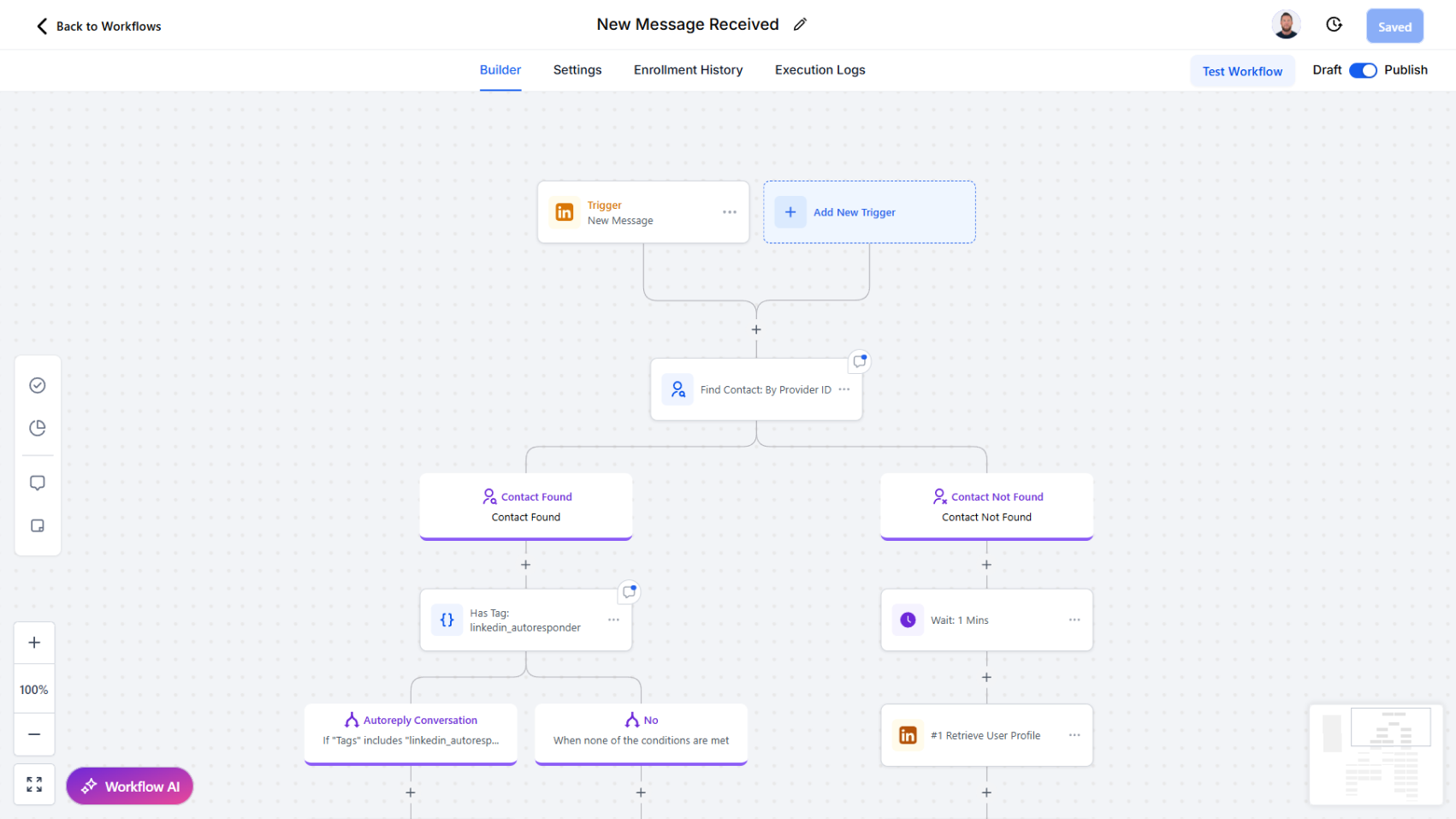New Message
Automatically trigger workflows whenever a new LinkedIn message is received. This trigger enables advanced automation such as contact enrichment, keyword filtering, tagging, or even AI-generated responses.

Trigger Overview
The New Message trigger activates a workflow when a new message arrives from a LinkedIn connection. It can be used to capture conversations into your CRM, trigger alerts, or drive automated responses.
⚠️ Important Notice for Snapshot Users
On installation, you must delete the New Message Trigger, save the workflow, refresh the page, re-add the trigger, save, and publish again.
This process registers the trigger with our backend software.
On installation, you must delete the New Message Trigger, save the workflow, refresh the page, re-add the trigger, save, and publish again.
This process registers the trigger with our backend software.
Use Cases
- Contact Enrichment – Look up the sender in your CRM. If they don’t exist, create a new contact record.
- Message Tracking – Capture conversation history to ensure sales, recruiting, or support teams have context.
- Keyword-Based Automation – Filter messages for specific keywords (e.g., "demo", "pricing") and trigger follow-up workflows.
- AI-Powered Autoresponders – Generate context-aware responses with AI by combining this trigger with the List All Messages action.
- Tagging & Segmentation – Automatically apply tags (e.g.,
linkedin_guidebook) to contacts based on message context.
Inputs and Required Data
This trigger does not require manual inputs. It automatically activates when a new message is received in LinkedIn.
Workflow Integration
Step-by-Step Guide
- Activate the Trigger – Add the New Message trigger to your workflow.
- Contact Lookup – Use the retrieved Provider ID to find the sender in your CRM.
- Conditional Branching:
- If Contact Found – Update existing contact with message details, tags, or trigger AI-based autoresponder flows.
- If Contact Not Found – Create a new contact using available LinkedIn profile data.
- Optional Filters – Add conditions to detect specific keywords or tags.
- Automated Actions – Trigger downstream steps like AI message generation, sending a response, or updating CRM fields.
Related Actions
- List All Messages – Retrieve conversation history to provide AI with context for response generation.
- Send A Message To A Chat – Automatically respond once the trigger fires.
- Retrieve User Profile – Enrich new contact records with full LinkedIn profile details.
Response
When triggered, the New Message trigger provides:
- Chat ID – Identifier of the conversation thread
- Message ID – Identifier of the specific incoming message
- Sender Details – Provider ID, Public ID, Name, and Profile URL (where available)
- Message Content – The text body of the received message
- Timestamp – When the message was received
Common Errors and Troubleshooting
Contact Not Found
- Cause: Sender not yet in CRM
- Solution: Use the "Create Contact" action as a fallback when the trigger activates.
API Connectivity Issues
- Cause: LinkedIn account disconnected
- Solution: Reconnect LinkedIn integration in your CRM before resuming workflows.
Best Practices
- Use If-Else branching after this trigger to distinguish between known and unknown contacts.
- Apply tags like
linkedin_autoresponderto clearly separate AI-managed conversations. - Always retrieve the last few messages for context before sending automated replies.
- Keep autoresponder messages professional and concise to maintain credibility.
Advanced Tips
- AI Integration – Combine this trigger with List All Messages and an AI response generator to build natural, context-aware chatbots.
- Randomized Response Times – Add delays or random wait times to mimic human behavior when sending automated replies.
- Keyword Routing – Route messages containing high-priority terms (like "proposal", "meeting") to human reps immediately, while AI handles general queries.